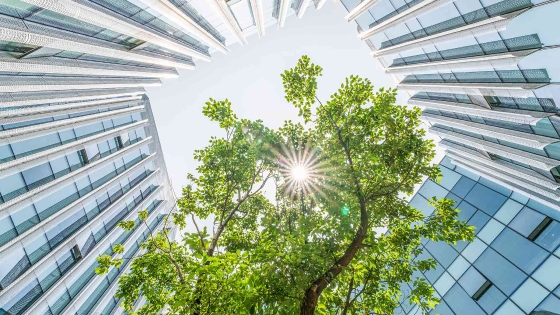Adopting sustainable practices has become a productive topic for governments, businesses, and individuals alike. The global industrial landscape is making a gradual shift toward a green future and constructing effective strategies to lower the carbon footprint. The urgency of reaching net-zero emissions has pushed decision-makers across different sectors to innovate and transform their operations to accommodate sustainability in the ecosystem.
The term 'green building' has gained traction over the internet as a constructive strategy in favour of the environment. While the concept is attracting a lot of attention, its popularity is met with a slight sense of ambiguity. What is a green building? What does it imply, and what are some of its benefits? These are questions that come to the mind of a potential buyer or an investor. This article addresses all these questions. A green building improves a facility’s overall efficiency in terms of water, energy, and materials usage coupled with lowering the overall impact on people's health and the environment through a better design, construction approach, routine operations, maintenance, and waste removal.
What is a Green Building?
Before we get into the pros and cons of green buildings, it's important to understand what is green building? The term "green building" refers to a facility that is both sustainable and high-performing. From site selection to design, construction, operation, maintenance, renovation, and deconstruction, green building is the discipline of developing buildings and employing ecologically responsible and resource-efficient procedures. This strategy expands and supplements the traditional architectural design aims of use, durability, and comfort. Green buildings, also known as sustainable structures, use less energy and water and are essential to climate-resilient urban development.
What Are the Benefits of Green Buildings?
Green buildings are a promising alternative to traditional buildings. The evidence that green buildings have various benefits is developing worldwide. They are among the most effective tools for accomplishing various global goals, including combating climate change, fostering sustainable and vibrant communities, and boosting economic growth.
Green buildings can not only lessen our impact on the planet but can also prove beneficial for the planet. By generating their own energy, they can help the environment. Some of the most common benefits of green buildings are:- Efficient Resource Usage: One such environmental benefit of green buildings is the efficient use of shared resources. Water is a limited shared resource, and its unabated consumption has put excessive strain on the overall supply. These limited resources are being safeguarded thanks to breakthroughs, sustainable practices, and technology made by brilliant architects worldwide. Green buildings may reduce the environmental effect on such resources by enhancing efficiency, allowing them to be maintained and kept for future generations.
- Energy-Efficient: Energy efficiency is a fundamental priority in green building design. They consume less energy than a regular traditional building. Developing structures that get their energy from natural sources like the sun, wind, and water is great for the environment since it protects the ecosystem from the pollution caused by non-renewable sources. Non-renewable energy sources are not only hazardous but also expensive, whereas energy-efficient alternatives can save thousands over the infrastructure's lifespan expenses. Green buildings in the United States and other countries that have earned the LEED certification have been demonstrated to use 25% less energy and 11% less water than non-green buildings.
- Reduces Carbon Footprint: Green buildings can also help in reducing the resident's carbon footprint. Building owners, investors, and major corporations have taken notice of this benefit. They have shown an interest in understanding what is green building and how it can be beneficial. They are willing to invest in these structures since growing sustainability is a chance to do good for both company and society.
- Financial Upper Hand: Green buildings provide significant economic benefits compared to traditional facilities. Cost-cutting on utility bills for tenants or families (due to energy and water efficiency); cheaper construction costs and better property value for project developers; increased occupancy rates or operating expenses for building owners; and employment creation are to cite a few benefits.
- Good for the Residents: Besides the numerous environmental benefits of these structures, green buildings are great for the residents. They can benefit from the better living conditions of green buildings. Occupants living or working in green structures have seen a significant increase in their health, stress levels, and general quality of life due to design components such as better natural lighting sources, thermal conditions, and even improved air quality.
- Protects Our Ecosystem: Global warming and climate changes are at an all-time high. There is an undeniable need for strong immediate steps by people to lessen the environmental impact. Sustainable building not only makes people healthier but also helps the ecosystem. Green building may help promote and preserve a cleaner environment by reducing our dependency on non-renewable resources.
- Employs Renewable Energy: Green buildings use renewable energy such as solar energy, wind energy, and hydropower. These renewable energy sources are a great way of minimizing the impact on the planet and reducing the strain on our dwindling natural resources. Renewable energy is not only great for the environment but presents a productive way to save money.
Constructing a Greener Tomorrow with Green Yodha
Green Yodha by Schneider Electric is a sustainability initiative that aims to take collective action to adopt energy efficiency and a new world of electricity to meet sustainability goals. Our panel of experts can help you understand what is green building and guide your efforts in the right way. Sustainable upgrades, decarbonization processes, electricity optimization, and the development of effective recycling materials are some of the services we provide to make houses more efficient and dependable. We can produce top-tier designs for facilities by combining our advisory services with our knowledge, an unrivaled array of offerings, and digital innovation.
The planet needs heroes like you right now
Become a Green Yodha. Join the good fight.


